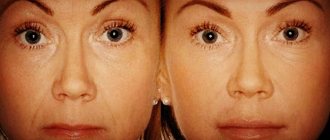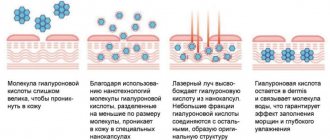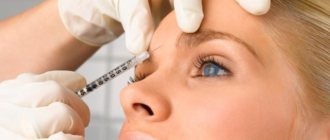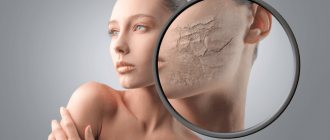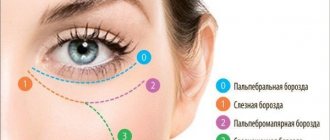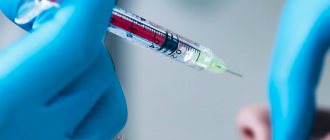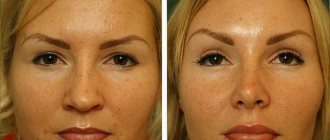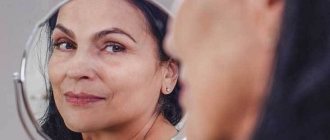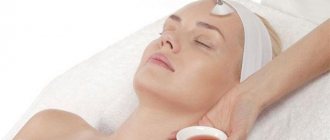Which hyaluronic acid is best for the face?
Hyaluronic acid is the guardian of youth and beauty, which is initially present in the human body. But the content of natural “hyaluronic acid” gradually decreases after 25 years, and withering and aging of the skin begins to progress. Then various drugs with HA compounds come to the rescue, which restore the water balance of the dermis. So which hyaluronic acid is best for the face?
Hyaluronic acid and collagen. Rules for taking collagen
In the topic “What is collagen. Types and sources of collagen” we talked about why we need collagen in principle. Today we will talk about how to take collagen supplements correctly.
Let me remind you once again about the types of collagen
Types 1 and 3 are found mainly in places such as: skin, tendons, bones, cornea, placenta, arteries, liver, dentin (bone substance of the tooth) (1) and arteries, uterus, fetal skin, stroma of parenchymal organs (connective tissue base parenchymal organs, which include the liver, spleen, endocrine and exocrine glands, brain and others) (3).
Type 2 – in cartilage, intervertebral discs, vitreous body, cornea. It is often contained in preparations of another product that we will take for our rejuvenation - hyaluronic acid, as well as preparations for joints.
That is, if we are interested in the process of rejuvenation of the body, primarily the skin, we use types 1 and 3. If there are problems with joints, then 2.
The effect of hyaluronate on the epidermis and dermis
A deficiency of “hyaluronic acid” in the body negatively affects the appearance: wrinkles appear, the skin takes on an unhealthy hue and loses its elasticity. With age, voids form in the collagen-elastin framework, which lead to “sagging” and weakening of individual areas of the skin. Cosmetic hyaluronic acid copes with these consequences - the best product for the face, which has a multidirectional effect on the skin.
Moisturizing and deep nutrition
Dehydration is the main factor that leads to premature aging of the dermis. Skin dehydration occurs due to improper care, excessive UV radiation and bad habits. Hyaluronic acid perfectly eliminates the lack of water in the body.
Hyaluronate is a reliable keeper of moisture in the human body. One molecule of hyaluronan can attract up to 1000 molecules of H2O, which makes this jelly-like substance a valuable assistant in preserving youth. By retaining and binding water, HA compounds provide strong strengthening of the skin framework. And moisturized and smooth skin is less susceptible to trauma in the future.
Performing a protective function
Hyaluronic acid for the face is also the best protector against aggressive environmental influences: poor ecology and abundant UV radiation. Many external care products (patches, tonics, lotions, serums) include HA compounds. When contacted with the epidermis, hyaluronate molecules form a retaining layer. It performs two important functions:
- maintaining a high concentration of H2O in cells;
- protection from dangerous external influences.
By wrapping the skin in a moisturizing blanket, hyaluronate also prevents the penetration of pathogenic microorganisms through damaged areas (scratches and microcracks).
Tissue regeneration
The best hyaluronic acid preparations for the face also provide other support to the body. Hyaluronate is a polysaccharide that is synthesized by connective tissue cells (fibroblasts) in the human body. With age, its natural production decreases, and a deficiency of “hyaluronic acid” forms in the body with negative consequences.
Hyaluronic acid is actively involved in cell profiling (reproduction). Hyaluronan molecules bind water in the body, which leads to increased skin turgor. In a well-moistened environment, important components of the extracellular matrix, collagen and elastin, are restored. It is these connective tissue proteins that are responsible for the smoothness and firmness of the skin. The gel-like composition also accelerates the healing of wounds and prevents the formation of scars.
Getting rid of harmful substances
Hyaluronic acid also improves facial skin by exhibiting its antioxidant properties. “Hyaluronic acid” protects the gel medium of the matrix, as it makes it impenetrable to the penetration of pathogenic microorganisms. As a result, a person receives additional protection from viruses (herpes). HA compounds also inhibit the formation of free radicals.
Formulas and types of hyaluronate
You may have heard about the various types of treatments used in cosmetology to maintain the correct rate of skin hydration. The medicine uses a formula (hyaluronic acid) synthesized in a laboratory of non-animal origin, with a very low risk of allergies. It is used in the field of ophthalmology (as a revolutionary method in cataract surgery), as well as in dermatology and cosmetology.
According to the chemical formula, there are two groups of hyaluronics in medicine with two different functions:
- non-crosslinked formulas that act as protectors/repairers;
- cross-linked, which are used as fillers.
In them, hyaluronate molecules are cross-linked or “intertwined” with each other to give them greater “strength” and durability. Protect from degradation factors to which they are exposed when entering the body. Thus, there are 2 types of hyaluronic acid: cross-linked and non-cross-linked.
- Stitched. Hyaluronic acid in the human body is a polysaccharide of the glycosaminoglycan family that is present in our body.
- Unstitched. It is a polysaccharide of the glycosaminoglycan family and is used as a bulking agent. When it penetrates the tissue, it does not cause an increase in volume, but acts as a water trap.
Types of hyaluronan depending on molecular weight
High molecular weight hyaluronan penetrates shallowly into the skin. Its moisturizing effect is enhanced by the formation of a thin film on the surface, which prevents cell dehydration.
Medium molecular weight penetrates into the middle layers of the fabric, providing a moderate moisturizing effect, keeping firmness and elasticity at an optimal level.
Low molecular weight penetrates deeply and has a high anti-wrinkle and anti-aging effect. One of its main functions is to retain water.
The effect of using hyaluronic acid
More than 50% of “hyaluronic acid” is included in the skin, and the rest of the natural substance is found in cartilage, joint fluid and heart valves. Scientists have found that the human body produces on average about 15 grams of natural hyaluronate, most of which is degraded under the influence of external factors.
Preparations based on HA compounds compensate for the deficiency of a valuable component. So which hyaluronic acid is best for the face? After all, the modern market offers a wide variety of cosmetics based on “hyaluronic acid”.
Injection procedures
Beauty injections involve the introduction of hyaluronic fillers into the deep layers of the skin. Such an effect allows the active substances to be transported directly to the epicenter - into the voids of the collagen-elastin framework. After GC injections, the following effect is noted:
- return of tone and healthy shade of the skin;
- elimination of aesthetic imperfections (wrinkles, folds, retracted scars);
- tightening the oval of the face and visually enlarging individual parts (lips, cheekbones).
Preparations for external care
Many patients are interested in: “Which hyaluronic acid is best to choose for the face?” Dermatocosmetologists often offer a more budget-friendly care option based on HA compounds - creams, serums, lotions, patches and tonics containing hyaluronan.
This type of care is aimed at improving the health of the outer skin. Once in the epidermis area, the HA cream creates a protective layer. This cosmetic film has the following effect:
- replenishment of moisture;
- increasing skin elasticity;
- smoothing wrinkles and eliminating peeling.
Use of dietary supplements
The use of dietary HA supplements is widespread - capsules and tablets, which are well absorbed by the body. Bioactive complexes based on hyaluronate - this is the best format of hyaluronic acid to choose for the face. Such compositions replenish the optimal level of hyaluronate and improve the functioning of many vital systems:
- increased joint mobility;
- moisturizing the mucous membrane of the eyes;
- return of skin elasticity, firmness and radiance;
- relief of the condition caused by atopic dermatitis.
How to replace hyaluronic acid at home
No one has yet managed to stop time and the natural processes of aging, but modern anti-aging cosmetics allow them to be deceived, since they have a pronounced rejuvenating effect and will help “throw off” a few extra years.
At the moment, one of the main components of anti-ageing cosmetics is hyaluronic acid. It is widely used in cosmetology for rejuvenation, smoothing wrinkles and toning the skin.
Hyaluronic acid is considered a universal and even ideal ingredient for any type of facial skin.
Content
Analogues and substitutes of hyaluronic acid
Many women are interested in whether it is possible to replace hyaluronic acid with anything? The structure of this substance is unique. For this reason, there are no absolute analogues of hyaluronic acid. However, there are drugs on the market that affect the human body in a similar way.
Peptides
Pharmacy analogues of HA are peptide preparations. They can rejuvenate the skin no worse than hyaluronic acid. According to current data, peptides in beauty formulas do not pose any potential danger to consumers and do not have strict restrictions on use. According to cosmetologists, they are well tolerated even by those with sensitive skin.
Recently, the so-called peptide anti-ageing cosmetics, which received their name because of the peptides they contain - biologically active substances that regulate various physiological processes in the body in general and the dermis in particular, have become increasingly popular in cosmetology.
Peptides regulate most processes in the human body, including taking part in cell regeneration processes.
With the help of peptide cosmetics, it has become possible to significantly slow down the aging process by remodeling damaged skin structures.
Oligopeptides maintain cellular activity at a high level, enhance regeneration processes, increase blood microcirculation, helping to saturate cells with oxygen and nutrients. This means that the natural mechanisms of antioxidant defense in the dermis are enhanced, it is better protected, and the cells are more resistant to lack of oxygen, the effects of toxic substances and other destructive agents.
Peptides also increase the production of collagen and elastin, helping restore skin turgor and smooth out wrinkles.
In cosmetic anti-aging products, such substances stimulate collagen production; relieve inflammation and enhance regeneration processes; increase blood microcirculation, helping to saturate cells with oxygen and nutrients; enhance natural antioxidant defense mechanisms; help eliminate age spots.
Injectable analogues - how to replace hyaluronic acid fillers
Sculptra and Radiesse - preparations based on poly-L-lactic acid (PLLA) and calcium hydroxyapatite
Those women who are looking for a replacement for hyaluronic acid fillers can be offered similar preparations that allow for contour correction of the face and body. These effective fillers have both their pros and cons.
Dermal fillers Radiesse and Sculptra were originally developed to restore lost facial tissue volume (lipoatrophy) in HIV-infected patients.
One of the most important advantages of fillers based on polylactic acid and calcium hydroxyapatite is their prolonged action - the correction effect lasts up to 2 years. Although some cosmetologists claim that with proper care it can be extended up to 36 months.
Among the disadvantages it is worth highlighting:
✓ the need for several sessions to obtain a positive result;
✓ there are age restrictions, since experts do not recommend the use of these fillers before the age of 35;
✓ the inability to remove the filler in case of an unsatisfactory result after correction, since they do not have such an antidote as hyaluronidase, which can quickly destroy hyaluronic acid;
✓ in the case of Sculptra, this is not a ready-made drug in syringes, but a lyophilisate, that is, a dry substance that will have to be diluted before use;
✓ Calcium hydroxyapatite spheres, according to some data, still do not completely biodegrade; this is more true in cases of non-use of hyperdilution (MesoRadiesse). One downside is that these fillers are unlikely to appeal to those who like the result “here and now,” since the client will not see the effect of the procedure immediately. This is due to the stimulation of the body’s formation of new collagen fibers, since collagen production begins 3-4 weeks after the injection of the filler.
How to use hyaluronic acid for facial skin
Before deciding on the application, let’s ask ourselves the question - is all hyaluronic acid the same?
The body continuously synthesizes and destroys native hyaluronic acid (the full replacement cycle for this substance is approximately 72 hours). As long chains of HA molecules gradually break down, fragments of very different lengths and molecular weights are formed. A set of these fragments - from 800 Da to 2 MDa - is present at any time in healthy tissues.
Based on their size, hyaluronan molecules are divided into certain fractions:
- Very high molecular weight: 3–20 MDa.
- High molecular weight: ~2 MDa.
- Average molecular weight: ~1 MDa.
- Low molecular weight: ~300 kDa.
- Very low molecular weight: ~60 kDa.
- Oligomers: from 800 Da to 10 kDa.
On a note. If your goal is effective deep hydration from the inside, buy a cream with low molecular weight hyaluronic acid. The type of structure of the substance is indicated either on the packaging or in the description of the product on the manufacturer’s official website.
Synthesized HA
Depending on the source and production technology, the molecular weight of hyaluronic acid can vary from 5 to 1000 kDa (kilodaltons) for low molecular weight HA and up to 1 million Da for high molecular weight HA. The longer the molecular chain of hyaluronic acid, the smaller the variation in molecular weight, the better the hydration. They fit perfectly on the surface of the skin and retain moisture there for a long time. Right from above.
If you destruct molecules into shorter ones, weighing from 100 to 400 thousand units, then they will begin to penetrate the stratum corneum of the epidermis. We still use such molecules as transport for water. They can be used for other things, but in our case - moisturizers.
The result is a highly effective sorbent that collects water and retains it in the dermal layers until the molecule falls apart as a result of vital processes in the body. If we break the molecules further, up to 10–40 thousand units, then they almost no longer retain water for the purposes necessary for our purposes. But with the help of them you can collect very interesting formulas that trigger regenerative processes and have a more pronounced anti-inflammatory and immunostimulating effect. Plus transport a variety of substances captured by these molecules as deeply as possible through the skin. The effect of such fractions is strikingly different from high-molecular fractions: almost no moisturizing, but very good subcutaneous penetration.
Types of hyaluronic acid
There are 3 types of hyaluronic acid:
- • unstabilized with low molecular weight;
- • unstabilized with high molecular weight;
- • stabilized (cross-linked).
Each type has its own duration of effect. The most effective and long-lasting are preparations of stabilized hyaluronic acid, which can remain in the skin for a long time and improve the functioning of the body’s own cells. The price will, of course, depend on these factors. Cross-linked HA is usually used in injection cosmetology, but recently it can be found in anti-aging cosmetics.
How to make hyaluronic acid at home
Hyaluronic acid can be obtained at home from rooster combs. These delicate, soft formations are essentially swollen gel.
At first, hyaluronic acid was exclusively of animal origin and for cosmetic purposes it was extracted mainly from the combs of roosters. Later, several methods were discovered for the synthesis of HA in industrial quantities using bacteria that produce it under certain conditions.
HA, obtained from animal raw materials, is a rather strong allergen, therefore it is almost never used in medicine and injection cosmetology, and is less often used in cosmetics.
However, for surface application it does not pose any danger, which means it can be used in home cosmetics, such as masks or creams.
To prepare it, you need to take 5 raw fresh scallops, wash and cook for about 15 minutes in clean water. Next, the scallops need to be removed from the broth. The broth must be cooled for 10-15 minutes, strained and poured into another clean pan, put on fire. When the excess liquid in the broth has evaporated, only hyaluronic acid will remain in the pan, which is what you will need for home use in a cosmetic product.
There is one very simple and cheap product that can effectively work for your beauty and youth - this is an ordinary eggshell.
Many people know that eggshells are the record holder for calcium content, but it turns out that they also contain a sufficient amount of hyaluronic acid, which makes it an ideal component in cosmetics.
The more shells you put in water, the more hyaluronic acid you get.
The shell must be thoroughly washed and the inner film removed. Using a coffee grinder, grind the shells into powder.
Take at least 3-5 tablespoons of crushed shells per 1 liter of water. The larger the shell, the higher the concentration of hyaluron. You need to wash and grind the shells, then add water. Place in a slow cooker for 10-12 hours, like jellied meat, and add water every half hour or hour as needed. Typically, you should get 200 ml of acid, but it is worth noting that the more shells there are in the water, the more acid you will get.
After the broth has cooled, you need to strain it through several layers of gauze. This resulting liquid is hyaluronic acid.
It is worth noting that allergies to such a product are possible, so I advise you to do a test before use. To do this, apply a little liquid to the skin of the elbow and wait a few hours. If no signs of allergy appear, then you can safely apply it to the skin of the face, neck and décolleté.
You can add the resulting liquid to a night or day cream, stir and apply to the skin in your usual way.
What does hyaluronic acid contain?
Table of products with hyaluronic acid
This table contains both products that directly contain hyaluronic acid and those that contribute to its production and preservation in the body. The second type of product is marked with an asterisk (*).
| Animal sources | |
| 1. Bone broths, jellied meats | Long boiling of the bones extracts HA from the bones into the broth |
| 2. Liver of poultry, beef, pork, lamb | |
| Vegetables | |
| 3. Cabbage | Rich in hyaluronic acid and collagen |
| 4. Starchy root vegetables (potatoes, sweet potatoes and other tubers) | |
| 5. *Leafy vegetables (lettuce, spinach, chard) | Contains magnesium, which triggers the production of HA |
| 6. *Beets | Contains lycopene, an antioxidant that enhances HA production |
| 7. *Red pepper | Contains lycopene, an antioxidant that enhances HA production |
| 8. *Carrot | Being rich in vitamin A and collagen, carrots stimulate the production of HA and help absorb collagen and elastin |
| 9. *Tomatoes | Contains naringin, which protects HA from breakdown |
| Fruits | |
| 10. Bananas | One of the few fruits that directly contain hyaluronate |
| 11. Olives and black olives | Yes, from a scientific point of view it is a fruit! And they are rich in HA. |
| 12. *Grapefruits, oranges and other citrus fruits | Contains naringin, which protects HA from breakdown |
| 13. *Cherry, strawberry, red grapes | Contains lycopene, an antioxidant that enhances HA production |
| 14. *Avocado | Contains magnesium, which triggers the production of hyaluronate |
| Nuts and seeds | |
| 15. Soybeans, soy products | Directly contain hyaronan |
| 16. *Beans, lentils, beans | Contains magnesium and zinc, which contribute to the production of HA |
| 17. *Almonds and cashews | Contains magnesium, which triggers the production of hyaluronic acid |
| Vegetables | |
| 18. Burdock | |
| 19. *Red wine | Contains phytoestrogens that promote the production of hyaluron |
| 20. *Dark chocolate | Contains magnesium and zinc, which also promote HA production |
It is not always possible to meet the body's needs with food. In this case, you should try taking supplements (dietary supplements) with hyaluronic acid.
Facial care at home: why home remedies are often more effective than store-bought cosmetics
Any cream consists of several components:
✓ Firstly, these are biologically active substances, they affect skin cells in a certain way depending on the purpose of the cream - anti-aging, moisturizing, restoration.
✓ The second important component is emulsifiers; they stabilize the cream base, the emulsion, which is water mixed with oil. Emulsion is used most often, as it allows biologically active components to be more easily absorbed into the skin tissue. But there is a very important point: the oil must be natural (almond or olive). Alas, mineral oil, which is a liquid extract from petroleum products, is most often added to cosmetic products.
✓ Preservatives also play an important role, because thanks to their antibacterial and antifungal effect, in most cases they prevent the risk of microbial growth in the cream and prolong its shelf life.
✓ And finally, fragrances give the cream a pleasant smell, but since they are most often the catalysts for allergic reactions, people with sensitive skin should choose fragrance-free creams.
Conditional classification of creams
• Moisturizer : glycerin, water, hyaluronic acid, collagen, elastin, urea, lactic acid.
• Anti-aging cream : retinol, vitamins A, E, C, coenzyme Q10, alpha-lipic acid, peptides, DMAE (dimethylaminoethanol).
• Regenerating cream : ceramides, lilac and lanolinic acids, phosphatidylcholine (lecithin), Asian centella extract, horse chestnut extract, panthenol, aloe vera extract.
• Cream for problem skin : salicylic acid, azelaic acid, AHA acids (alpha hydroxide), triclosan, retinoids, copper, zinc, sulfur, talc, clay, niacinamide.
Professional cosmetics or mass-market?
The effectiveness of cosmetic products applied to the surface of the skin largely depends on the absorption of the active ingredient, which means its ability to cross the epidermal barrier.
However, our skin is created by nature specifically to protect against aggressive external influences, so that pathogenic bacteria cannot enter the body, so it is very difficult to find substances that will overcome the transepidermal barrier and work in the deep layers of the skin (where the main aging processes occur). Unfortunately, many substances needed by the skin also do not have this ability.
Thus, the vast majority of inexpensive mass-market cosmetics (mass-market is a segment of the mass market) works only on the surface of the skin - moisturizes, protects from the sun, but does not provide a real anti-aging effect. After all, the task of producers in the low-cost segment is to reduce the price of their products as much as possible and make a profit.
Thus, creams that actually work in the subcutaneous layers should be sought mainly among professional cosmetics.
You can also use cosmetics prepared in salons by a cosmetologist from certain ingredients, since in any program of cosmetological correction using topical drugs, the issue of transepidermal delivery remains a priority.
Natural cosmetics without preservatives
In addition to the effectiveness of skincare products, the main condition for modern women is that cosmetics must be safe.
At the same time, beauty product manufacturers face certain difficulties. We need to create a cosmetic product to which most people will not have an allergic reaction.
A systemic reaction to hyaluronic acid is quite a rare occurrence, but do not forget that although it is present in most skin care products, it is not always the main component; in addition, in addition to hyaluronic acid, there are also other components - which means you should be careful with the main ingredients. Therefore, manufacturers often play it safe, and in the bulk of cosmetics (with the exception of professional ones) the concentration of active ingredients is ineffective (and catchy names on the packaging are just ordinary marketing ploys). Of course, any product should be preserved for as long as possible - ideally at least a year. This means you need to add preservatives, since natural ingredients quickly deteriorate. This is also somewhat of a problem - many women are wary of them - recently preservatives have become the subject of consumer intimidation.
Of course, we want anti-aging cosmetics to be natural, but we should be frank: when buying them for ourselves or for our mother, we ask first of all what exactly this cream can do, how effective it is, and only then the question of its safety is raised.
On the other hand, as mentioned above, a properly selected preservation system is one of the main safety factors.
However, there are still no alternative preservatives that provide the same broad spectrum of protection at low dosages as traditional preservatives. But producing cosmetics with a short shelf life is unprofitable; retail chains are extremely reluctant to sell them.
Is there a way out of this situation? One of the options is cosmetics made with your own hands at home.
Homemade anti-wrinkle cosmetics
What is the difference between face care cosmetics made with your own hands and store-bought counterparts?
Firstly, in home cosmetics you can only use safe ingredients (hyaluronic acid is an absolutely safe substance), including natural ones. From this it follows that the composition is completely known.
Secondly, you control the percentage and concentration of active ingredients in home cosmetics yourself, so you can use the trial method to select exactly the product that is ideal for you, depending on the condition of the skin, age and other conditions.
Thirdly, there is no need to add preservatives to the composition, since the prepared products are used immediately. In order to have constantly fresh cosmetics, it makes sense to produce them in small volumes.
Fourthly, home remedies are simply more profitable - for the same cost you can get a cream with much more expensive ingredients and in a higher dosage.
Natural cosmetics should be so safe that, figuratively speaking, you can eat them without fear.
What ingredients in face creams are considered harmful?
If we talk about modern cosmetics, experts are of the opinion that there are no clearly harmful components in beauty products, since the content of most components in perfumes and cosmetics is very strictly regulated. In order to increase the level of consumer health protection, European/Russian regulations have been created, and all manufacturers of beauty products are required to adhere to them.
All products falling under the definition of “perfume and cosmetic products (cosmetics)”, when placed on the market in the European Union, must be accompanied by a COSMETIC PRODUCTS SAFETY REPORT - a report on the safety of cosmetic products.
The content of components that can cause any negative reactions should be minimized to the extent required by safety standards for use. Therefore, in principle, there is no need to talk about any obvious danger to the health of consumers of modern cosmetic products (provided that they are certified). The main “harmfulness” of modern cosmetics is individual intolerance to individual components of the composition, which can cause allergic reactions and irritation on the skin. For example, it can sometimes occur in relation to hyaluronic acid, although it is an important component of dermal tissue and should be safe. Therefore, it should be clarified that the human body forms an immune response not to pure hyaluronate, but only to impurities found in the preparation based on it, residual protein traces. The composition of the product and its effectiveness are, of course, the most important points, but your feelings are no less important, so you should check it. Apply a little product to the back of your hand and evaluate the texture.
— The cream is light, absorbs well and is practically not felt on the skin? So this is what we need.
— After application, does a greasy film remain for a long time, is there any redness, itching or just discomfort? Then this is definitely not your option.
Under what conditions can hyaluronic acid dry out the skin?
Sometimes on forums, in reviews, women write that hyaluronic acid dries out the skin. It's likely that you've also heard horror stories about water-binding substances, such as hyaluronic acid or glycerin, that they actually dry out the skin. But these are moisturizers, right?
It's simple - being in a dry climate, where there is insufficient air humidity, these components can actually draw water from the skin and “give it” to the environment. However, here you should understand what a “dry climate” is.
A dry climate is typical for African countries (Algeria, Egypt, Morocco) or, for example, countries in the Middle East (Afghanistan, Saudi Arabia, Turkey). In central Russia, for example, in Moscow, even the summer period is not a dry climate.
This is not a reason to exclude hyaluronic acid from “use”.
Use it correctly and it will moisturize effectively even in the driest climates.
For example, apply a hyaluronic acid serum under the cream. Or, just use a cream with hyaluronic acid in the composition. These creams contain film-forming components that will “lock” the moisture collected by hyaluronic acid and prevent it from evaporating.
Hyaluronic acid in the salon
There are many different injection techniques with which hyaluronic acid-based preparations are delivered to the subcutaneous layers. The most popular and effective procedures for combating the signs of chrono- and photoaging are mesotherapy; biorevitalization; bioreparation; contour plastic; bioreinforcement; redermalization.
— Mesotherapy is the subcutaneous administration of meso-cocktails containing hyaluronic acid, vitamins, microelements, amino acids, oligoelements, lipolytics, and peptides. Mesotherapy can be injection (that is, biologically active substances are delivered directly under the skin through injections) and non-injection (hardware). The procedure will help eliminate fine wrinkles, significantly improve the condition and quality of the skin, increase its elasticity, and improve complexion.
— Biorevitalization (bios (from Greek) - life, revitalization (from English) - revitalization) is a cosmetic procedure that is aimed at restoring the natural level of hyaluronic acid. It is carried out by injecting preparations based on hyaluronic acid into the skin. Biorevitalization accounts for about 30% of the total number of cosmetic interventions. Biorevitalization can significantly improve the condition of the skin, moisturize it, and achieve visual rejuvenation for 5–15 years. It can also be used to prevent early signs of aging.
— Bioreparation is an injection procedure for the prevention, rejuvenation and elimination of cosmetic imperfections of the skin. In addition to hyaluronic acid, bioreparation preparations include a vitamin-mineral complex, amino acids and peptide compounds that stimulate collagen production and create a supply of nutrients. After bioreparation, the effect does not disappear for 6 months. After biorevitalization, the effect will be noticeable on average for 3-4 months.
— Redermalization is an injection procedure using hyaluronic acid and sodium succinate (succinic acid). Redermalization is aimed at preventing age-related changes, and is also a powerful tool for eliminating signs of fatigue and skin defects that have already appeared on the face. Helps restore skin by preventing dehydration and blocking free radicals. The effect of the procedure is achieved by increasing its regenerative potential.
— Facial contouring is a generalized name for invasive procedures during which fillers (a gel filler containing biosynthetic hyaluronic acid) are injected subcutaneously through injections to fill folds and irregularities, allowing for additional volume to be given to certain areas. It is used to eliminate wrinkles and asymmetry, tighten the facial contour, add additional volume, smooth out scars and scars, and lip correction. A single procedure allows you to get an effect that lasts from six months to one and a half years.
— Bioreinforcement (i.e. “creating a frame”) is a procedure for intradermal administration of hyaluronic acid gels using a special vector system or grid pattern. The introduction of a biostimulator stimulates the process of neocollagenesis, which leads to the formation of a vector “framework” inside the dermis - this will restore the contours of the oval of the face, eliminate its “sagging”, increase skin tone and turgor, and smooth out fine wrinkles on the face and neck. A suitable procedure with hyaluronic acid injections should be selected by a cosmetologist based on skin type, severity of problems, age and other characteristics.
Cons of hyaluronic acid injections
Of course, you can’t do this with injections alone: the procedure will have to be repeated in six months or maybe a little longer - it depends on the type of procedure and the characteristics of the skin.
And the second, not so obvious, but very significant minus is that you can psychologically become “dependent” on beauty injections. After all, no skin care products, even professional ones, can replace injections - after women see how quickly injectable hyaluronic acid rejuvenates, they can hardly voluntarily refuse such procedures.
To keep your skin young as long as possible, you need to:
✓ — Strengthen the protective barrier: the weaker it is, the more the dermis loses moisture, becomes dry, thin and dull, burns more easily in the sun and recovers worse. This leads to irritation, redness, inflammation, allergic reactions and provokes skin diseases (for example, dermatitis). A damaged natural barrier can be restored if you choose the right care. It includes gentle cleansing plus creams and masks containing a competent mix of moisturizing components, physiological (skin-related) lipids and film-forming substances. Daytime hyaluronic cream acts as additional protection against ultraviolet radiation, so its use is especially recommended in summer.
✓ — Stimulate skin renewal: physiological restoration determines how long the skin of the face and body will retain its youth and beauty. Regeneration (renewal) of the skin occurs constantly, and this means that the epidermis is able to recover at the cellular level. If the pace or quality of natural regeneration has slowed down, then it is worth intensifying it. A serum with hyaluronic acid is ideal for this, because the concentration of active substances in the serum is many times higher than their amount in the cream. However, it is worth remembering that the serum is best used in tandem with cream: adding a few drops to it and mixing before application, or “covering” the serum layer with cream.
✓ - Provide antioxidant protection: Antioxidants protect against free radicals and help prevent damage to body cells caused by oxidative processes. To protect against free radicals, there is a large group of biologically active compounds in food, vitamins, dietary supplements and cosmetics. Below are foods that are high in antioxidants.
What foods contain antioxidants?
A diet rich in antioxidants is what you need to prolong youth and beauty. Therefore, it will be useful to know which products contain them.
Vitamin C - citrus fruits, rose hips, red bell peppers (paprika), spinach, fresh tea leaves
Vitamin A - butter, fish oil, milk, egg yolk, fish and animal liver, caviar
Provitamin A (beta-carotene) - spinach, carrots, beets, pumpkin, apricots, peaches, red peppers, tomatoes
Vitamin E (tocopherol) - cereal seeds, vegetable oils (soybean, corn, cottonseed), egg yolk, vegetables, legumes, wheat germ oil
Vitamin B2 (riboflavin) - milk, meat, egg yolk, legumes, yeast
Vitamin B5 (pantothenic acid) - liver, peanuts, champignons, lentils, chicken eggs, peas, onions, cabbage, oatmeal
Vitamin B6 - salmon, sardines, sunflower seeds, sweet peppers, bran bread, wheat germ
Omega-3 - fish (salmon, tuna, sardines, halibut, pink salmon), fish oil, seafood
Omega-6 - vegetable oils, nuts, sesame, pumpkin seeds
Coenzyme Q10 - beef, herring, chicken, sesame seeds, peanuts, broccoli
Resveratrol - skins of black grapes, red wine.
In addition to hydration, you also need protection.
When the skin's protective function is impaired, certain elements from the environment, such as allergens or aggressive substances from polluted air, easily penetrate the skin and can cause irritation, which is characterized by skin hypersensitivity such as itching, tingling, redness...
First barrier: fat (lipid barrier)
This protective layer, which is a natural part of the epidermis, consists primarily of fatty acids. It is called a hydrolipid film. The dermis produces essential lipids that fill the spaces between cells on the skin's surface called corneocytes, thus creating a natural defense against potential irritants. This protective barrier also helps retain moisture, creating a more hospitable environment for beneficial bacteria on the skin.
The second obstacle: the skin’s own “living” ecosystem
Research shows that the microbiome (microflora) of the skin protects it thanks to the billions of different bacteria that live on its surface. The healthy appearance of the skin largely depends on beneficial microorganisms that protect it and help regulate processes in the dermis.
How to strengthen both protective barriers?
You can strengthen the protective function of the skin with the help of cosmetics containing prebiotics.
• To restore the hydrolipid layer, look for products with a combination of active emollients, moisturizers and moisture-retaining components. Thanks to the effect on the metabolic and biochemical processes of renewal of the deep layer of the skin, therefore, rejuvenation occurs not only at the external level, but also at the cellular level.
• To regulate the microbiome of the epidermis, pay attention to products with a prebiotic formula that provide a beneficial nutrient medium for bacteria.
Thus, by restoring both barriers - the lipid layer of the skin and the microbiome - we strengthen the natural protective function of the dermis, which promotes the rejuvenation of skin cells.
Are cosmetics alone sufficient for care?
Any cosmetics for home use - creams, masks, etc. are not able to overcome the transdermal barrier. They interact only with the top layer. With their help, you can only slightly nourish and moisten the surface; they are not able to replace complex measures.
Visible positive changes are only possible if renewal occurs at the cellular level. But for this it is already necessary to use professional cosmetics or hardware procedures that can launch renewal processes and stimulate the synthesis of new cells.
How quickly does our skin renew itself?
Keratinocytes are the main dermal cells of human skin, continuously dividing in its lower layers, growing and gradually moving to the outer layers of the epidermis, where they die, turning into the stratum corneum. Next, the dead cells exfoliate, giving way to newer ones.
Each age is characterized by its own time cycle, but over the years it slows down:
- — Until the age of 25, the rate of skin regeneration is 27-28 days
- – Between 25-35 years – about 29 days
- – Between 35-45 years – 31-32 days
- - Between 45-55 years - approximately 32-36 days,
- — After 60 years, regeneration processes slow down to 2-3 months and enter the stabilization stage, the skin gradually loses moisture, its firmness and elasticity, and pronounced wrinkles and folds appear.
Skin renewal methods
There are different ways to stimulate cellular renewal.
- Mechanical . This is how scrubs work, for example. The targets for abrasive particles are exclusively dead cells.
- Chemical . With the help of acids, you can carry out both superficial peeling, affecting only dead cells, and deeper peeling, aimed at solving a specific aesthetic problem.
Chemical peeling is based on the action of chemical agents (most often acids) and allows you to remove dead skin layers to a given depth, while simultaneously stimulating the regeneration of young cells. Today, this method of aesthetic medicine still remains one of the most popular. The popularity of chemical peeling is due to its high efficiency, combined with a relatively low cost. Unlike their physical and mechanical counterparts, chemical peels are simple to perform and do not require expensive equipment.
- Physical . The stratum corneum of the skin is damaged using physical energy (laser).
Modern aesthetic medicine and cosmetology are constantly looking for new ways to maintain female beauty and youth. But a lot depends on the woman herself - the main rule that will maintain an impeccable appearance is regular, careful and carefully selected care.
The use of hyaluronic acid at home is a fairly effective treatment measure, but, of course, it cannot become an equivalent replacement for biorevitalization and mesotherapy.
Unlike beauty injections, cosmetics and skincare treatments have a superficial effect. Therefore, you should not expect radical rejuvenation from the independent use of hyaluronic acid.
Facial cosmetics containing HA compounds
Discovered by Karl Mayer in 1934, hyaluronic acid has become an essential component of many skin care products. There are two types of hyaluronate used in cosmetics production:
- a high-molecular composition that is delivered deep into the dermis using invasive procedures;
- low molecular weight composition of crushed HA particles, forming a special moisture-retaining layer on the skin.
So which hyaluronic acid cares for your face better than other products? The Japanese company KWC, which develops complexes for preserving beauty, offers an extensive line of luxury HA products.
KWC Hyaluronic Acid
A complex product of 60 capsules has a systemic rejuvenating effect on organs and tissues. The dietary supplement with an improved formula includes not only hyaluronan molecules, but also other substances that enhance its properties: beta-carotene, collagen, biotin and vitamin C.
The HA product saturates the skin with moisture and accelerates the regeneration of damaged tissue. The complex is also recommended for use to increase joint mobility and rapid recovery after surgery. KWC capsules with hyaluronan are the best hyaluronic acid for the face and body.
4 700
rub
Add to Basket
Buy in one click
KWC Super-enriched toning lotion with hyaluronic acid and collagen
KWC enriched lotion is made on the basis of hyaluronate, crushed into small particles. The tonic contains collagen, proteins and amino acids - these components awaken the activity of natural fibroblasts.
4 300
rub
Add to Basket
Buy in one click
The rich texture of the drug is complemented by the work of extracts of seaweed, Barbados cherry and sakura:
- narrowing of pores;
- improvement of blood supply;
- relieving swelling and redness;
- regeneration and nutrition of the skin;
- whitening and elimination of aesthetic unevenness;
- protection against microbes that cause inflammatory processes.
Super-enriched HA lotion from KWC is the best hyaluronic acid for faces with combination to dry skin.
KWC Super-enriched repair emulsion with hyaluronic acid and collagen
The regenerating emulsion from KWC is made on the basis of a triple combination of “Collagen + Hyaluronic acid”. The first part of the supplement is a safe complex of 3 substances of the collagen family:
- hydrolyzed – strengthens connective tissue fibers;
- soluble – increases H20 concentration and increases elasticity;
- succinyl atelocollagen – accelerates the biosynthesis of collagen and elastin fibers.
4 300
rub
Add to Basket
Buy in one click
Triple hyaluronate is presented as a set of 3 components:
- high molecular weight composition – forms a moisture-retaining layer on the skin;
- supermolecular acid – improves skin absorption capacity;
- low molecular weight composition – reduces the depth of wrinkles.
KWC emulsion is one of the best preparations based on hyaluronic acid for the face, because it is suitable for owners of any skin type. The nutritional composition has the following visual effect:
- elimination of irritation and swelling;
- creating tightened and silky skin;
- reduction of pigment spots and evening out tone.
KWC Super-enriched revitalizing face cream with hyaluronic acid and collagen
KWC super cream with an enriched formula includes the following substances:
- collagen hydrolyzate;
- low molecular weight hyaluronate;
- Acerola (Barbados cherry) fruit extract
- placental protein
- vitamin C
- sakura leaf extract;
- vitamin E and squalane.
7 660
rub
Add to Basket
Buy in one click
Squalane (a natural substance) improves the barrier properties of the skin, and tocopherol (vitamin E) normalizes lipid balance. Thanks to its unique composition, this cream has a comprehensive effect, restoring the natural radiance of the skin.
KWC Extra-hydrating mask with hyaluronic acid
A moisturizing mask from a Japanese brand is the best product to choose for your face with hyaluronic acid.
2 920
rub
Add to Basket
Buy in one click
This set includes 6 sachets with disposable extra masks. The main component of the composition is hyaluronate, the work of which is enhanced by other active ingredients. A complex of HA compounds, brown seaweed and Irish moss gives the magic of instant transformation:
- complete nutrition and deep hydration;
- providing a slight brightening effect;
- restoration of facial contours and color.
The combination of all components in the KWC fabric mask allows you to restore the water balance of the dermis and improve its condition.
Excerpt characterizing Lignoceric acid
-Where is the fur coat? - said Dolokhov. - Hey, Ignatka! Go to Matryona Matveevna, ask for a fur coat, a sable cloak. “I heard how they were taking away,” Dolokhov said with a wink. - After all, she will jump out neither alive nor dead, in what she was sitting at home; you hesitate a little, there are tears, and dad, and mom, and now she’s cold and back - and you immediately take it into a fur coat and carry it to the sleigh. The footman brought a woman's fox cloak. - Fool, I told you sable. Hey, Matryoshka, sable! – he shouted so that his voice was heard far across the rooms. A beautiful, thin and pale gypsy woman, with shiny black eyes and black, curly, bluish-tinged hair, in a red shawl, ran out with a sable cloak on her arm. “Well, I’m not sorry, you take it,” she said, apparently timid in front of her master and regretting the cloak. Dolokhov, without answering her, took the fur coat, threw it on Matryosha and wrapped her up. “That’s it,” said Dolokhov. “And then like this,” he said, and lifted the collar near her head, leaving it only slightly open in front of her face. – Then like this, see? - and he moved Anatole’s head to the hole left by the collar, from which Matryosha’s brilliant smile could be seen.
Contraindications for use
Hyaluronic acid is a natural polysaccharide that is originally included in the human body. Therefore, when using GC drugs, rejection and allergies do not occur. But there are contraindications, in the presence of which it is worth discussing therapy with the best hyaluronic acid for the face with a doctor:
- poor blood clotting;
- pregnancy and lactation;
- active use of anticoagulants;
- fresh connective tissue damage;
- exacerbation of any chronic diseases;
- hypersensitivity to other components of the composition.
How to choose the right one
To determine the most correct ways to choose products with hyaluronic acid, you must first separate the options for its use:
- The most effective way to use it is considered to be various cosmetic procedures in specialized centers. Most often, hyaluronic acid is delivered to the skin by injection. If the center has all the necessary certificates and is demanding about the quality of work of its personnel and components for carrying out procedures, then this method is the most effective and safe. Therefore, when choosing a center, it is best to focus on reviews about it, the duration of work, the availability of necessary certificates and education among doctors;
- the second way is to use various brands of skincare cosmetics from creams to various balms with hyaluronic acid. Today the choice is very large, from budget lines that anyone can buy to luxury cosmetics. Below we will talk about what you need to pay attention to when choosing a skin care product;
- the third method is quite controversial, since there are no official statistics on how it works. But on the Internet you can now find many instructions on how to make cream with this ingredient at home. This option is completely budget-friendly, since not very expensive components are used, which are saturated with hyaluronic acid by mixing.
Why did the third method appear? The fact is that hyaluronic acid in its pure form can be bought at any pharmacy. It is sold there as a drug, available without a prescription and is quite accessible. And since cosmetic procedures in specialized centers are quite expensive, they came up with this way of reproducing procedures in a beauty salon.
Since all pharmaceutical products undergo mandatory testing and certification, there is no doubt that this method of replenishing the supply of hyaluronic acid in the skin is safe, but only if recommended.
When choosing a drug, follow our instructions:
- There is no need to refuse this drug, explaining this by disgust and the origin of the drug. Now this substance is no longer extracted from animal tissues (quite specific, it should be noted). You definitely won't rub anything into your skin that has been extracted, for example, from the eyes of a cow. On the contrary, hyaluronic acid is now produced by germinating special bacteria under sterile conditions;
- read the composition carefully. If you want the substance to penetrate deeper into the skin, it is better to use a product containing low molecular weight hyaluronic acid. When using this product for making masks and creams, you can get a more delicate and light texture;
- check the expiration date;
- view manufacturer information. We can recommend the following to you: Evalar (Russia) - the drug is called Laura, the American company Solgar produces a drug of the same name, the German company Doppel Herz, the Japanese company KWC.
Of course, it is difficult to achieve the same effect as during a procedure in a beauty salon, but in any case, the effect will be much higher than you might expect.
Myths and truth about hyaluronic acid
Does your skin not look as smooth as it did a few years ago?
Don't worry. Today, anti-aging preparations that contain hyaluronate are very popular. However, there are myths about hyaluronic acid.
- Hyaluronate is contraindicated in patients over 50 years of age.
Lie! Each person is individual, so you should first consult with a specialist.
- If you use filler once, you will become addicted.
Not true! As with all treatments, if the patient is in the hands of good specialists, such a problem cannot exist. Doses are strictly selected individually for each patient.
- The effect of hyaluronate is temporary.
Is it true! If you want smooth skin over time, you need to use injectable treatments repeatedly. The effect of the medicine lasts up to approximately 9 months.
